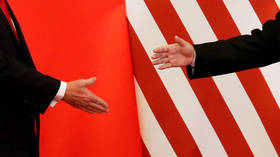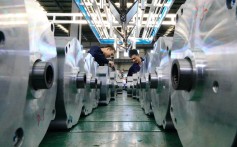- Joined
- Nov 29, 2016
- Messages
- 5,674
- Points
- 63
https://www.rt.com/business/477035-tariffs-failed-fed-study/
Trump’s tariffs hurt more than helped, leading to job losses & higher prices - Fed study
29 Dec, 2019 09:07
Get short URL

FILE PHOTO: Ford's Kansas City Assembly Plant © Reuters / Dave Kaup

US tariffs meant to boost the US economy by eliminating “unfair” trade practices, primarily by China, actually took a toll on manufacturing sector jobs and hiked prices, a study by the US Federal Reserve Board has concluded.
The Fed has become the latest body to stress the damaging consequences of “unprecedented” punitive tariffs unleashed by US President Donald Trump on China and other trade partners - including Canada, Mexico and the EU - at the beginning of 2018. In a recently released report, Fed economists Aaron Flaaen and Justin Pierce said that the negative effects of the measure outweighed the benefits, at least in the short term.
Read more
 The good, the bad & the ugly about US-China trade breakthrough
The good, the bad & the ugly about US-China trade breakthrough
“We find that tariff increases enacted in 2018 are associated with relative reductions in manufacturing employment and relative increases in producer prices,” the paper says.
According to the Fed report, US industries working with aluminum and steel faced the biggest increase in prices, as new import levies accounted for 17.6 percent of costs for aluminum sheet producers, and 8.4 percent of costs for steel products manufactured from purchased steel.
Some American manufacturers could have benefitted from reduced competition in the domestic market, but tit-for-tat tariffs lowered their competitiveness overseas. This affected a range of industries, the study found, including magnetic and optical media, leather goods, aluminum sheet, iron and steel, motor vehicles, household appliances, audio, video and computer equipment.
While some industries managed to enjoy a degree of import protection thanks to the tariffs, this was offset by “larger drags” from rising input costs and retaliatory measures, according to the paper. The economists state that longer-term effects may be different, as US companies can adjust their supply chains to avoid US import levies, but they could also choose to relocate outside of the US, as claimed by some earlier studies.
Also on rt.com US mulls boosting EU tariffs as WTO says Airbus keeps getting European subsidies
“Our results suggest that the traditional use of trade policy as a tool for the protection and promotion of domestic manufacturing is complicated by the presence of globally interconnected supply chains,” the report concludes.
Washington and Beijing are currently trying to finalize phase one of their trade deal, with both sides currently working on the text and other procedures necessary to ink the agreement. The world’s two biggest economies have imposed tariffs on billions of dollars’ worth of each other’s goods, with a new round of tariffs averted by the recent breakthrough.
Meanwhile, another US trade war with the European Union is still raging. After the World Trade Organization (WTO) ruled that the EU paid improper financial subsidies to airplane manufacturer Airbus, thus hindering sales by US rival Boeing, the Trump administration imposed punitive tariffs on EU goods. The US imposed record duties on Airbus planes and agricultural products like French wine, Italian cheese and Scotch whisky, and has recently threatened the EU with new hikes.
For more stories on economy & finance visit RT's business section
Trump’s tariffs hurt more than helped, leading to job losses & higher prices - Fed study
29 Dec, 2019 09:07
Get short URL
FILE PHOTO: Ford's Kansas City Assembly Plant © Reuters / Dave Kaup
- 59

US tariffs meant to boost the US economy by eliminating “unfair” trade practices, primarily by China, actually took a toll on manufacturing sector jobs and hiked prices, a study by the US Federal Reserve Board has concluded.
The Fed has become the latest body to stress the damaging consequences of “unprecedented” punitive tariffs unleashed by US President Donald Trump on China and other trade partners - including Canada, Mexico and the EU - at the beginning of 2018. In a recently released report, Fed economists Aaron Flaaen and Justin Pierce said that the negative effects of the measure outweighed the benefits, at least in the short term.
Read more
“We find that tariff increases enacted in 2018 are associated with relative reductions in manufacturing employment and relative increases in producer prices,” the paper says.
According to the Fed report, US industries working with aluminum and steel faced the biggest increase in prices, as new import levies accounted for 17.6 percent of costs for aluminum sheet producers, and 8.4 percent of costs for steel products manufactured from purchased steel.
Some American manufacturers could have benefitted from reduced competition in the domestic market, but tit-for-tat tariffs lowered their competitiveness overseas. This affected a range of industries, the study found, including magnetic and optical media, leather goods, aluminum sheet, iron and steel, motor vehicles, household appliances, audio, video and computer equipment.
While some industries managed to enjoy a degree of import protection thanks to the tariffs, this was offset by “larger drags” from rising input costs and retaliatory measures, according to the paper. The economists state that longer-term effects may be different, as US companies can adjust their supply chains to avoid US import levies, but they could also choose to relocate outside of the US, as claimed by some earlier studies.
Also on rt.com US mulls boosting EU tariffs as WTO says Airbus keeps getting European subsidies
“Our results suggest that the traditional use of trade policy as a tool for the protection and promotion of domestic manufacturing is complicated by the presence of globally interconnected supply chains,” the report concludes.
Washington and Beijing are currently trying to finalize phase one of their trade deal, with both sides currently working on the text and other procedures necessary to ink the agreement. The world’s two biggest economies have imposed tariffs on billions of dollars’ worth of each other’s goods, with a new round of tariffs averted by the recent breakthrough.
Meanwhile, another US trade war with the European Union is still raging. After the World Trade Organization (WTO) ruled that the EU paid improper financial subsidies to airplane manufacturer Airbus, thus hindering sales by US rival Boeing, the Trump administration imposed punitive tariffs on EU goods. The US imposed record duties on Airbus planes and agricultural products like French wine, Italian cheese and Scotch whisky, and has recently threatened the EU with new hikes.
For more stories on economy & finance visit RT's business section


